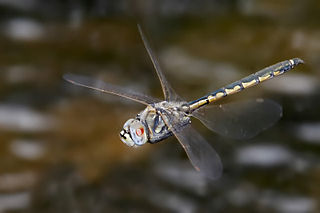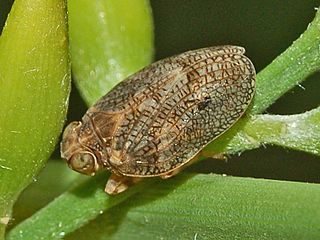
Jumping spiders are a group of spiders that constitute the family Salticidae. As of 2019, this family contained over 600 described genera and over 6,000 described species, making it the largest family of spiders at 13% of all species. Jumping spiders have some of the best vision among arthropods and use it in courtship, hunting, and navigation. Although they normally move unobtrusively and fairly slowly, most species are capable of very agile jumps, notably when hunting, but sometimes in response to sudden threats or crossing long gaps. Both their book lungs and tracheal system are well-developed, and they use both systems. Jumping spiders are generally recognized by their eye pattern. All jumping spiders have four pairs of eyes, with the anterior median pair being particularly large.

The froghoppers, or the superfamily Cercopoidea, are a group of hemipteran insects in the suborder Auchenorrhyncha. Adults are capable of jumping many times their height and length, giving the group their common name, but many species are best known for their plant-sucking nymphs which produce foam shelters, and are referred to as "spittlebugs".
Constriction is a method used by several snake species to kill or subdue their prey. Although some species of venomous and mildly venomous snakes do use constriction to subdue their prey, most snakes which use constriction lack venom. The snake strikes at its prey and holds on, pulling the prey into its coils or, in the case of very large prey, pulling itself onto the prey. The snake then wraps one or two loops around the prey, forming a constriction coil. The snake monitors the prey's heartbeat to ascertain it is dead. This can be a physically demanding and potentially dangerous procedure for the snake, because its metabolism is accelerated up to sevenfold and it becomes vulnerable to attack by another predator.

Animal locomotion, in ethology, is any of a variety of methods that animals use to move from one place to another. Some modes of locomotion are (initially) self-propelled, e.g., running, swimming, jumping, flying, hopping, soaring and gliding. There are also many animal species that depend on their environment for transportation, a type of mobility called passive locomotion, e.g., sailing, kiting (spiders), rolling or riding other animals (phoresis).
Robot locomotion is the collective name for the various methods that robots use to transport themselves from place to place.

Insects are the only group of invertebrates that have evolved wings and flight. Insects first flew in the Carboniferous, some 300 to 350 million years ago, making them the first animals to evolve flight. Wings may have evolved from appendages on the sides of existing limbs, which already had nerves, joints, and muscles used for other purposes. These may initially have been used for sailing on water, or to slow the rate of descent when gliding.

Mudskippers are any of the 23 extant species of amphibious fish from the subfamily Oxudercinae of the goby family Oxudercidae. They are known for their unusual body shapes, preferences for semiaquatic habitats, limited terrestrial locomotion and jumping, and the ability to survive prolonged periods of time both in and out of water.

Campaniform sensilla are a class of mechanoreceptors found in insects, which respond to local stress and strain within the animal's cuticle. Campaniform sensilla function as proprioceptors that detect mechanical load as resistance to muscle contraction, similar to mammalian Golgi tendon organs. Sensory feedback from campaniform sensilla is integrated in the control of posture and locomotion.

Torkel Weis-Fogh was a Danish zoologist and Professor at the University of Cambridge and the University of Copenhagen. He is best known for his contributions to the understanding of insect flight, especially the clap and fling mechanism used by very small insects. James Lighthill named this "the Weis-Fogh mechanism of lift generation".

A planthopper is any insect in the infraorder Fulgoromorpha, in the suborder Auchenorrhyncha, a group exceeding 12,500 described species worldwide. The name comes from their remarkable resemblance to leaves and other plants of their environment and that they often "hop" for quick transportation in a similar way to that of grasshoppers. However, planthoppers generally walk very slowly. Distributed worldwide, all members of this group are plant-feeders, though few are considered pests. The infraorder contains only a single superfamily, Fulgoroidea. Fulgoroids are most reliably distinguished from the other Auchenorrhyncha by two features; the bifurcate (Y-shaped) anal vein in the forewing, and the thickened, three-segmented antennae, with a generally round or egg-shaped second segment (pedicel) that bears a fine filamentous arista.

Portia labiata is a jumping spider found in Sri Lanka, India, southern China, Burma (Myanmar), Malaysia, Singapore, Java, Sumatra and the Philippines. In this medium-sized jumping spider, the front part is orange-brown and the back part is brownish. The conspicuous main eyes provide vision more acute than a cat's during the day and 10 times more acute than a dragonfly's, and this is essential in P. labiata′s navigation, hunting and mating.

Michael Francis Land FRS was a British neurobiologist. He was a professor of neurobiology in the vision laboratory at the Sussex Centre for Neuroscience, University of Sussex, England.

Journal of Experimental Biology is a peer-reviewed scientific journal in the field of comparative physiology and integrative biology. It is published by The Company of Biologists. The journal is partnered with Publons and has two-way integration with bioRxiv. Journal of Experimental Biology is now a hybrid journal and publishes 24 issues a year. Content over six months old is free to read.
Ultrasound avoidance is an escape or avoidance reflex displayed by certain animal species that are preyed upon by echolocating predators. Ultrasound avoidance is known for several groups of insects that have independently evolved mechanisms for ultrasonic hearing. Insects have evolved a variety of ultrasound-sensitive ears based upon a vibrating tympanic membrane tuned to sense the bat's echolocating calls. The ultrasonic hearing is coupled to a motor response that causes evasion of the bat during flight.

Issus is a genus of planthoppers belonging to the family Issidae of infraorder Fulgoromorpha of suborder Auchenorrhyncha of order Hemiptera. Like most members of the order Hemiptera they live on phloem sap that they extract with their piercing, sucking mouth parts.
Charles Porter Ellington FRS was a British zoologist, emeritus Fellow Downing College, Cambridge, and professor emeritus at University of Cambridge.

Issus coleoptratus is a species of planthopper belonging to the family Issidae.
John Edwin Treherne was an English entomologist who specialized in insect biochemistry and physiology and conducted extensive experimental studies. He was also a noted author, including the historically located The Galapagos Affair (1983) which he wrote after spending some time in the Galapagos conducting research.
Hemisquilla is a genus of mantis shrimp, and the only genus in the family Hemisquillidae. It contains four species distributed in Australia and the Americas. Species in the genus typically eat snails, fish, rock oysters, and smaller crustaceans like crabs. They are preyed upon by larger bony fishes and cephalopods. It is the most basal living mantis shrimp lineage, and the sister group to all other mantis shrimp.

The femoral chordotonal organ is a group of mechanosensory neurons found in an insect leg that detects the movements and the position of the femur/tibia joint. It is thought to function as a proprioceptor that is critical for precise control of leg position by sending the information regarding the femur/tibia joint to the motor circuits in the ventral nerve cord and the brain














